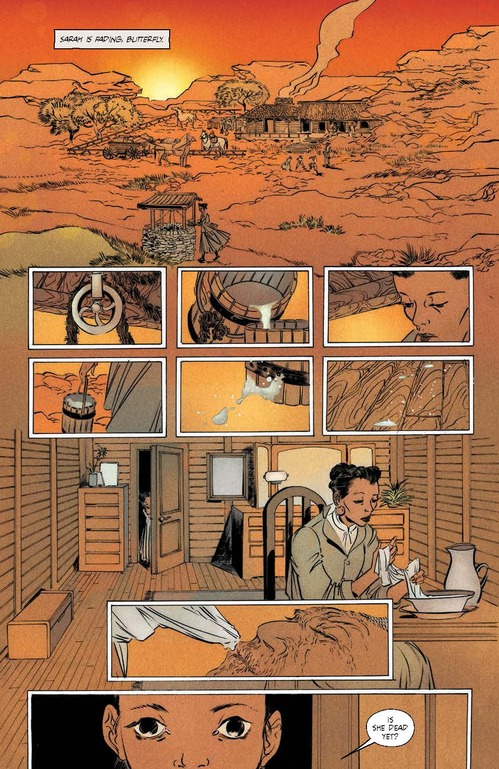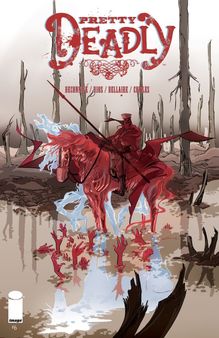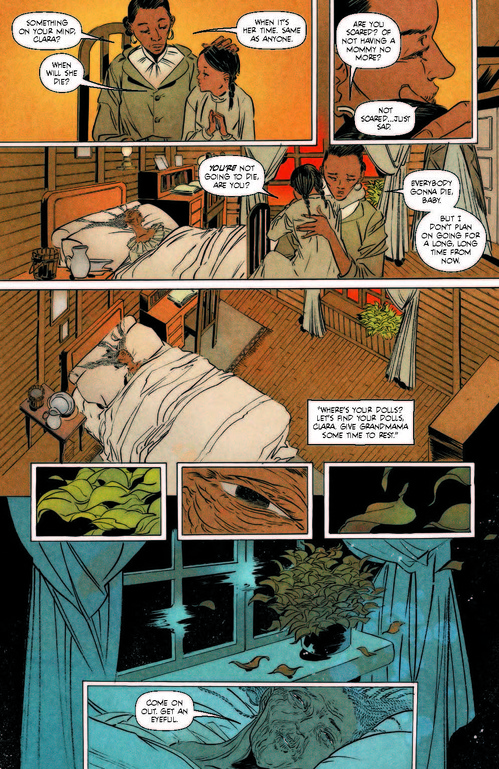“I Don’t Make Work That Is For Everyone, And That Is Okay”: Kelly Sue DeConnick on the Return of Pretty Deadly
Pretty Deadly is both a title and a description: a gorgeous, lethal book, uninterested in holding the reader’s hand. Returning to shelves this week after a hiatus that allowed writer Kelly Sue DeConnick to launch Bitch Planet with Valentine DeLandro, Pretty Deadly bolts forward in time to the trenches of World War I without sacrificing the samurai-western atmosphere of the first five issues.
DeConnick is no stranger to strong reactions. As she readily admits, readers tend to love or hate her work with little room between, and Pretty Deadly offers a challenge. It’s a layered, poetic work often more concerned with tone and feeling than with narrative simplicity. Spanish artist Emma Ríos fills the pages with ornate layouts and dense panels complemented by vibrant work from colorist Jordie Bellaire and swirls of text from letterer Clayton Cowles.
In advance of issue #6 released this week, in which near-silent protagonist Deathface Ginny rides across Europe in pursuit of a young soldier named Cyrus, Paste caught up with DeConnick to discuss her close collaboration with Ríos, the specific magic of the comic form and why she’s okay with not writing for everyone.![]()
Paste: The second volume of Pretty Deadly leaps forward in time to the muddy, blood-filled trenches of World War I Europe, with Deathface Ginny dispatched to track down a young soldier named Cyrus at the behest of his dying grandmother. The first story arc put an ethereal fantasy spin on the Western genre—is your goal here to do the same for war stories?
Kelly Sue DeConnick: I got that same question from David Brothers at Image and it’s so smart, I sure wish I had thought of that. [Laughs] I suppose it is a war comic, but I still think of it as a western. I guess it’s not, I guess it is a war comic. I’m so used to thinking in terms of characters. I don’t really think of genre—genre sort of just happens. It feels like that sort of categorization is for someone else to do. There are certainly scenes that take place in the trenches, but it’s still an alternate mythology. It’s still a story of how larger forces affect human beings and trying to come to terms with that. The first arc was about trying to understand death. The second arc is about trying to understand war.
Ginny is still a cypher. She’s kind of like [Sergio Leone’s] The Man With No Name. She’s very hard to get to know. She doesn’t really talk, which is a problem writing her. [Laughs] It’s like, would you please just tell me something? But that’s what we wanted out of her, that was the whole point of her. We wanted to see what a lady Man With No Name was, and she is that. She’s a pain in the ass to write.
Paste: Speaking with Paste about volume one, you cited influential samurai and western films like Lady Snowblood in helping set the tone for your writing. What sort of research, historical or fictional, left an imprint on the second arc?
DeConnick: Emma has cited All Quiet on the Western Front, Paths of Glory, La Grande Illusion, Joyeux Noël, the paintings of Polish artist Zdzislaw Beksinski, and Otto Dix. I did some reading about the 369th. They’re called the Harlem Rattlers or the Harlem Hellfighters, although apparently they called themselves the Rattlers. John Keegan’s The First World War. I listened to Dan Carlin’s Hardcore History five-part podcast, “Blueprint for Armageddon”; it’s a five-part series and it’s really, really long, something like 12 hours.
We did all that research and obviously the visuals of the trenches make it into the book, the basic understanding of how they were laid out. But the number of deaths and just how overwhelmingly bleak the First World War was… I’m having trouble articulating it. Populations were thinned. It is so hard to wrap your brain around the number of casualties. It’s not comparable to anything we’ve experienced, thank god. Things like The White Feather Brigade, who were these women who went around pinning white feathers on young men who had not enlisted, marking them as cowards…
There’s nothing about it that wasn’t horrific. But the specifics don’t really make it onto the page, because it’s not a story about the larger forces of the war. It’s not a history. Even though the 369th certainly informed it, it’s not about any of the men of the 369th. It’s about this guy Cyrus who we created. So we did a lot of research to kind of get the feeling and understand the horror of that period, but it doesn’t directly make it to the page, with the exception of Emma’s eye for making sure the costumes are correct and the trenches are correct.

Pretty Deadly #6 Interior Art by Emma Rios & Jordie Bellaire
Paste: Is Cyrus a co-protagonist for this arc? Or is he more the target that Ginny is hunting throughout the story?
DeConnick: We treat Ginny like she’s the protagonist and we put her on the covers and everything, but she is like The Man With No Name. She has an arc in the first arc, but hers isn’t as easy to identify as that of Sissy, or the redemption arc of the Mason. You could make the argument that the most profound arc is that of Beauty, who is barely on the page. The whole thing begins when she is imprisoned and then she frees herself. So it’s hard to say.
-

-

-

-

-

-

-

-

-

-

-

-

-

-

-

-

-

-

-

-

-

-

-

-

-

-

-

-

-

-

-

-

-

-

-

-

-

-

-

-













































